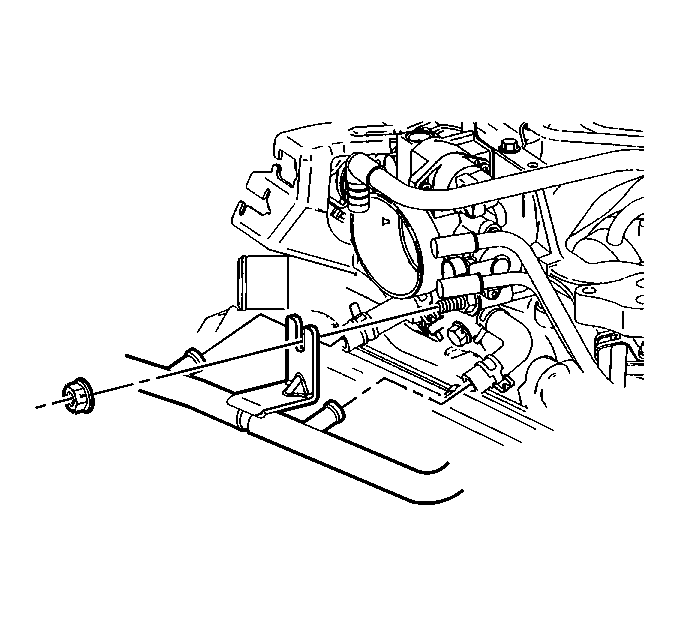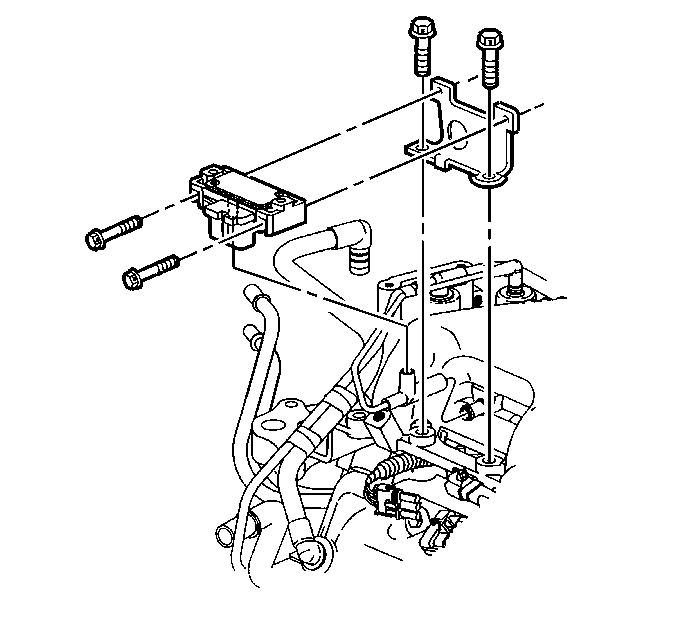Removal Procedure
Important: This engine uses a sequential multiport fuel injection system. Connect the injector connectors to their appropriate fuel injector or exhaust emissions and engine performance may be seriously affected. For the correct connector to injector connection procedure, refer to SECTION 8A.
- Disconnect the negative battery cable. Refer to
Caution: Unless directed otherwise, the ignition and start switch must be in the OFF or LOCK position, and all electrical loads must be OFF before servicing any electrical component. Disconnect the negative battery cable to prevent an electrical spark should a tool or equipment come in contact with an exposed electrical terminal. Failure to follow these precautions may result in personal injury and/or damage to the vehicle or its components.
in General Information. - Remove the air cleaner and duct.
- Remove the accelerator control and cruise control cable from the throttle body.
- Remove the accelerator control cable bracket. Move the cable aside.
- Remove the thermostat bypass pipe clip nut from the upper intake manifold.
- Remove the automatic transaxle vacuum modulator pipe.
- Remove the power brake booster vacuum hose from the manifold.
- Remove the engine mount strut at the engine. Refer to Engine Mount Strut Replacement .
- Rotate the engine. Refer to Rotating the Engine for Service Access .
- Remove the electrical connectors from the ignition coil.
- Remove the ignition coil.
- Remove the generator front and rear braces. Refer to SECTION 6D3.
- Remove the electrical connectors from the manifold.
- Remove all of the necessary vacuum hoses.
- Remove the MAP sensor.
- Remove the exhaust gas recirculation (EGR) valve.
- Remove the upper intake manifold studs.
- Remove the upper intake manifold bolts.
- Remove the upper intake manifold.
- Remove the upper intake manifold gasket.
- Clean the gasket with degreaser.
- Clean the seal surfaces on the manifold with degreaser.



Installation Procedure
- Install the upper intake manifold gasket.
- Install the upper intake manifold.
- Install the upper intake manifold studs and bolts.
- Install the exhaust gas recirculation (EGR) valve.
- Install the MAP sensor.
- Install all of the necessary vacuum hoses.
- Install the electrical connectors to the manifold.
- Install the generator front and rear braces. Refer to SECTION 6D3.
- Install the ignition coil.
- Install the electrical connectors to the ignition coil.
- Rotate the engine. Refer to Rotating the Engine for Service Access .
- Install the engine mount struts at the engine. Refer to Engine Mount Strut Replacement .
- Install the power brake booster vacuum hose to the manifold.
- Install the automatic transaxle vacuum modulator pipe.
- Install the thermostat bypass clip nut to the upper intake manifold.
- Install the accelerator control cable bracket.
- Install the accelerator control and cruise control cable to the throttle body.
- Install the air cleaner and duct.
- Connect the negative battery cable.

Tighten
Tighten the studs and bolts to 25 N·m (18 lb ft).
Notice: Use the correct fastener in the correct location. Replacement fasteners must be the correct part number for that application. Fasteners requiring replacement or fasteners requiring the use of thread locking compound or sealant are identified in the service procedure. Do not use paints, lubricants, or corrosion inhibitors on fasteners or fastener joint surfaces unless specified. These coatings affect fastener torque and joint clamping force and may damage the fastener. Use the correct tightening sequence and specifications when installing fasteners in order to avoid damage to parts and systems.


